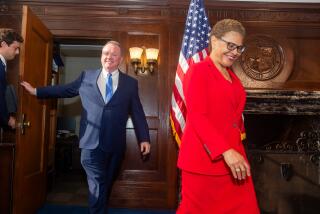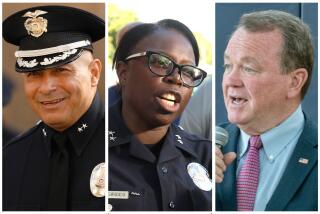At FBI’s Busy Los Angeles Office, Time for a Changing of the Guard
LOS ANGELES — From his 17th-floor Westwood office, FBI Special Agent Charlie J. Parsons has watched the Getty Center grow, one imported brick at a time, toward its future as a Los Angeles cultural monument. From the opposite side of the same floor, he watched Los Angeles burn, put to the torch by its own residents in the riots of 1992.
And now, exactly five years after coming to take charge of one of the busiest law enforcement offices in the nation--responsible for most federal law enforcement in this complicated, contradictory city--Parsons is leaving his Westwood post and retiring from the FBI. His retirement was effective Friday.
His departure, which caps an era marked by sharp crime reductions and improved community relations for the local FBI, is part of an exodus of top talent from the Los Angeles division: Jerry D. Thornton, an assistant chief of the office, is retiring next month, and Kathleen L. McChesney, the division’s second in command, is heading to Portland, Ore., next week. She will become the second woman in the history of the bureau to head an FBI field office.
Combined, the three agents have nearly three-quarters of a century of FBI service. Their tenures in Los Angeles have been marked by extraordinary growth and activity by the division here.
Since Parsons arrived in 1991, the office has grown by more than 100 agents, refocused scores of investigators from foreign counterintelligence to street crime, mended fences with the Los Angeles Police Department even as the office helped put two LAPD officers in federal prison, unearthed a dangerous group of skinheads, and cracked down on gangs from the Mexican Mafia to street criminals who terrorize South Los Angeles neighborhoods.
Not all of those efforts have been universally praised. Some authorities say new gang members have filled the void created by the prosecutions of Mexican Mafia leaders, and some trumpeted operations have yielded disappointing numbers of serious arrests.
Nevertheless, joint local-federal task forces are operating at an all-time high locally. Officials can point to area after area in which violent crimes and serious felonies have dramatically declined.
The bureau even reversed an alarming trend in Southland bank robberies which were skyrocketing in the late 1980s and early 1990s.
“For a while there,” said Special Agent William Rehder, who supervises the Los Angeles FBI’s bank squad, “all we were trying to do was stomp on these brush fires.”
*
Under Parsons’ leadership, bank executives have joined regular meetings with FBI agents and have installed more rigorous security measures. FBI agents have arrested key leaders in the bank robbery trade, and federal prosecutors have helped put those robbers behind bars for long prison terms. Southland bank robberies have plummeted from a high of 2,641 in 1992 to 1,122 last year.
The drop is so pronounced that the FBI, which used to include the sardonic motto “Bank Robbery Capital of the World” on its Los Angeles faxes, has replaced it with pictures of palm trees, movie cameras and the Hollywood sign.
“I’m awfully proud of what we’ve accomplished,” said Parsons, whose East Texas gentility masks a steely investigator skilled in organized crime work. “It’s difficult to leave.”
Parsons arrived in Los Angeles in 1991 to find a division perched on the edge of controversy. A few months earlier, on Thornton’s first day, the FBI had received its copy of the videotaped beating of Rodney G. King. The FBI has jurisdiction to investigate complaints of civil rights abuses, and there was no mistaking the significance of the King tape.
“It was an interesting way to start,” Thornton recalled wryly.
By the time the King investigation was over, relations with the LAPD--historically never strong--were badly frayed. But at the same time, relations with many black residents seemed to be on the rebound.
Those ties got another boost when the FBI thwarted a group of young skinheads who were building bombs and plotting to use them to kill King and others, including a chillingly planned idea to scatter pipe bombs through the First African Methodist Episcopal Church, one of the city’s most renowned religious centers.
On Jan. 17, 1994, the congregation gathered to pay homage to the investigators who headed off the threat. “Charlie Parsons reinvigorated the image of the FBI generally . . . and [with] African Americans specifically,” said First AME’s pastor, the Rev. Cecil Murray. “We look upon him as a bit of an earthly redeemer.”
“There’s no question that it changed the image of the FBI with a number of African Americans,” Parsons said. “That wasn’t the reason we did the case. It wasn’t the reason we did Rodney King, either. But that was perhaps a dividend. There was more trust in the FBI.”
*
Ask Parsons for evidence of the FBI’s success, and he turns to the statistics--one neighborhood at a time. In each, the FBI has joined with local authorities to launch sustained campaigns against crime problems. In some, the numbers show major reductions in reported violent felonies.
In Nickerson Gardens in Watts, reports of violent crime are down 34% since 1991. In nearby Imperial Courts, serious felonies fell 47% from 1992 to 1995, with murders down a third, as more than 250 suspected gang members were charged with crimes. And in the Oakwood area of Venice, where authorities arrested an alleged gang leader after a black-Latino gang war, robberies have fallen 60% and aggravated assaults 68%.
Crime-fighting by statistics is notoriously difficult, and decreases in some areas sometimes mask increases nearby. Moreover, the statistics reflect reported crime, not actual crime, and fearful residents sometimes elect not to call authorities for fear of exposing themselves to retaliation.
Nevertheless, local and federal authorities say the concentrated focus on those and other neighborhoods has given some relief to residents and has helped build ties among the agencies responsible for maintaining public safety.
“It’s pretty much common knowledge that relations have never been better between the U.S. attorney’s office and the FBI, as well as between our agencies and the local authorities,” said Nora Manella, U.S. attorney for the Central District of California.
Today, 29 task forces involving the FBI, Los Angeles County Sheriff’s Department, LAPD and other agencies bring local and federal investigators together on a regular basis. Some tackle ongoing problems such as street crime, others pursue fugitives or reopen old murder cases.
Although some have exceeded expectations, others, such as a major FBI-LAPD initiative known as Operation Sunrise, have rounded up mostly petty criminals but failed to nab major targets.
*
In addition to the task forces, Parsons and his colleagues have reached out to local authorities in personal ways, attending meetings, seminars and conferences and stressing their willingness to discuss ideas and operations with local authorities. In 1995, Parsons became the first FBI agent since 1949 to head the Peace Officers Assn. of Los Angeles County.
LAPD Deputy Chief Bernard C. Parks, the current president of that group, said Parsons’ efforts have helped smooth the historical mutual suspicion between the FBI and LAPD.
Despite the thaw of recent years, rumors still occasionally crop up: Last year, some LAPD officers briefly became convinced that the FBI was sending agents undercover to pose as gang members in order to test how Los Angeles cops would react to them. The rumor was false but pervasive.
“Charlie has been a part of keeping those rumors to a minimum,” Parks said. “He’s been very open as to what he could provide to us.”
Today, Parsons and McChesney pack up their offices and take their leave. Parsons heads to Drug Abuse Resistance Education, the international organization founded in Los Angeles. He will become its new director, a position that he says will allow him to take aim at a problem that underlies many of the crimes he has fought throughout his career with the FBI.
Thornton leaves at the end of September, bound for a security position with Southern California Edison Co.
By Oct. 1, only McChesney still will carry an FBI badge. But she will take it to a height all but unknown to female agents.
When McChesney, who has been in the FBI 18 years, joined the bureau, she was one of about 100 female agents. Today, there are 1,200, and though very few have reached her level, there has been steady progress. “These things,” she said, “take time.”
They also take drive and determination, which McChesney’s peers credit her with in abundance. Prosecutors praise her skill and temperament; agents admire her oversight of administrative details. And all cite her commitment.
She takes over as head of the Portland office Tuesday morning.
More to Read
Sign up for Essential California
The most important California stories and recommendations in your inbox every morning.
You may occasionally receive promotional content from the Los Angeles Times.











